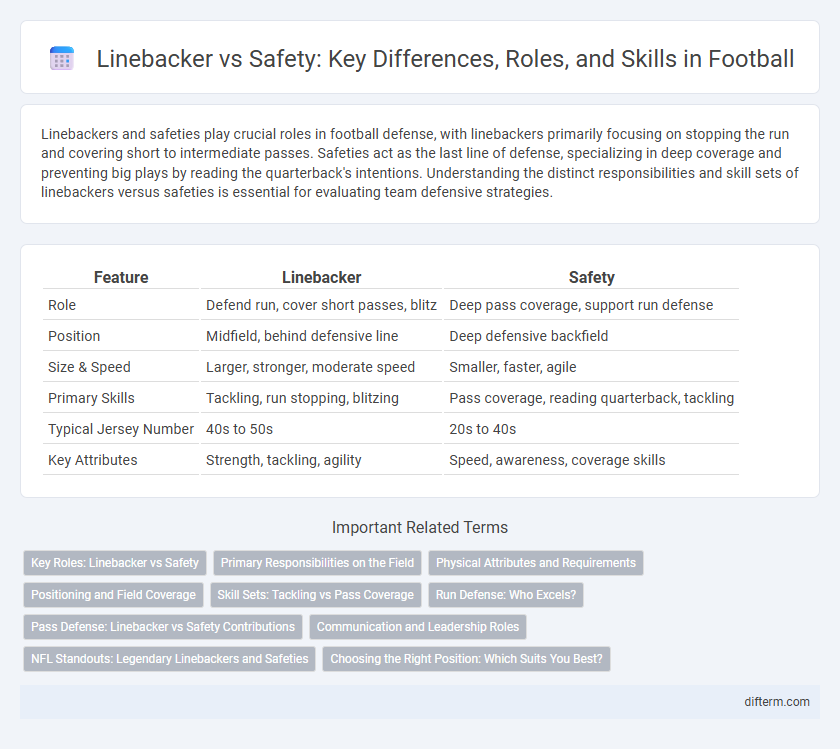Linebackers and safeties play crucial roles in football defense, with linebackers primarily focusing on stopping the run and covering short to intermediate passes. Safeties act as the last line of defense, specializing in deep coverage and preventing big plays by reading the quarterback's intentions. Understanding the distinct responsibilities and skill sets of linebackers versus safeties is essential for evaluating team defensive strategies.
Table of Comparison
| Feature | Linebacker | Safety |
|---|---|---|
| Role | Defend run, cover short passes, blitz | Deep pass coverage, support run defense |
| Position | Midfield, behind defensive line | Deep defensive backfield |
| Size & Speed | Larger, stronger, moderate speed | Smaller, faster, agile |
| Primary Skills | Tackling, run stopping, blitzing | Pass coverage, reading quarterback, tackling |
| Typical Jersey Number | 40s to 50s | 20s to 40s |
| Key Attributes | Strength, tackling, agility | Speed, awareness, coverage skills |
Key Roles: Linebacker vs Safety
Linebackers primarily focus on run defense and short-to-intermediate pass coverage, acting as the defensive backbone to stop rushing yards and contain tight ends or running backs. Safeties are tasked with deep pass coverage to prevent big plays, often serving as the last line of defense and providing support in both zone and man coverage schemes. While linebackers engage more in tackling and blitzing near the line of scrimmage, safeties excel in reading the quarterback and anticipating long passes.
Primary Responsibilities on the Field
Linebackers primarily focus on stopping the run and covering short to intermediate passing zones, using their size and strength to tackle ball carriers and blitz the quarterback. Safeties are responsible for deep pass coverage, reading the quarterback's intentions to prevent long completions and providing support in run defense when necessary. Both positions require quick decision-making and strong tackling skills, but linebackers play closer to the line of scrimmage while safeties cover the deeper areas of the field.
Physical Attributes and Requirements
Linebackers typically exhibit greater size and strength, averaging 6'2" and 240 pounds, enabling them to engage in heavy tackling and block shedding. Safeties prioritize agility and speed, often around 6'0" and 200 pounds, to cover wide receivers and support pass defense effectively. Both positions demand high football IQ and quick decision-making skills to adapt to dynamic game situations.
Positioning and Field Coverage
Linebackers typically position themselves closer to the line of scrimmage, focusing on defending against runs and short passes in the middle of the field. Safeties play deeper in the defensive backfield, providing coverage over the top and supporting both pass defense and run support. Their strategic placements optimize field coverage by balancing front-line aggression with deep-field vigilance.
Skill Sets: Tackling vs Pass Coverage
Linebackers excel in tackling due to their proximity to the line of scrimmage and physicality, often engaging in run defense and blitzing. Safeties specialize in pass coverage, utilizing speed and agility to defend against deep passes and support cornerbacks in coverage. Effective defensive schemes rely on linebackers' tackling prowess to stop runs and safeties' coverage skills to disrupt passing plays.
Run Defense: Who Excels?
Linebackers excel in run defense due to their size, strength, and positioning closer to the line of scrimmage, allowing them to effectively fill gaps and tackle ball carriers. Safeties contribute to run support, but their primary role emphasizes deep pass coverage and secondary containment, limiting their impact on early run stops. Overall, linebackers dominate the run defense by consistently engaging blockers and disrupting running lanes.
Pass Defense: Linebacker vs Safety Contributions
Linebackers provide strong pass defense by covering short to intermediate routes and applying quarterback pressure, utilizing their size and tackling ability to disrupt plays. Safeties excel in deep pass coverage, using speed and awareness to prevent long completions and support cornerbacks in zone or man coverage. Together, linebackers and safeties create a layered defense that limits passing opportunities and forces quarterbacks into rushed decisions.
Communication and Leadership Roles
Linebackers serve as the defensive signal-caller, orchestrating alignments and adjustments to counter offensive schemes, demonstrating strong communication skills on the field. Safeties contribute by providing secondary coverage adjustments and relaying information from the back end, often acting as the last line of defense with a strategic perspective. Effective leadership in both positions ensures cohesive defensive execution and rapid response to offensive formations.
NFL Standouts: Legendary Linebackers and Safeties
Legendary NFL linebackers like Ray Lewis and Lawrence Taylor revolutionized defensive play with their intense tackling and leadership on the field, while renowned safeties such as Ed Reed and Troy Polamalu excelled in pass defense and game-changing interceptions. Linebackers are praised for their versatility in run stopping and pass coverage, often acting as the defense's core, whereas safeties specialize in deep coverage and forcing turnovers. Their complementary roles have defined defensive strategies, showcasing the distinct skills that make linebackers and safeties NFL standouts.
Choosing the Right Position: Which Suits You Best?
Linebackers excel in stopping the run and covering short to intermediate passes, requiring size, strength, and quick decision-making, making them ideal for players who thrive in physical, close-quarters combat. Safeties prioritize pass coverage and deep field awareness, demanding speed, agility, and strong communication skills to guard against long completions and support run defense. Assess your athletic strengths and play style to determine if the linebacker's physicality or the safety's versatility fits your ideal football role.
linebacker vs safety Infographic

 difterm.com
difterm.com